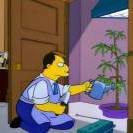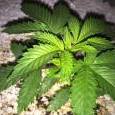Leaderboard
Popular Content
Showing content with the highest reputation on 11/05/2018 in all areas
-
Charlette angel CBD extact3 points
-
First proper small SCROG attempt, Master Kush and Cali orange advice is welcome, thanks2 points
-
SSH started indoor and trained, then moved to greenhouse and further trained its been fun one so far2 points
-
2 points
-
2 points
-
Awe guys, so my mate held a workshop this weekend and it seems to be blowing up... https://www.news24.com/SouthAfrica/News/cape-town-dagga-workshop-tickets-sell-out-in-2-days-201811051 point
-
Whats good everyone! Hoping this will be my second successful grow, I am still a noob to everything, but ive learned a ton on this site so im excited to share my next grow with everyone . My first grow was in coco/perlite. I enjoyed the vigorous growth the coco offered, but having to be home everyday to feed my plants really took its toll & towards the end of flower i ran into plenty issues. Thus prompting a move to a more forgiving medium, Freedom Farms soil! Lights 2 x 60watt 3000k quantum boards, ill be using for veg & flower Medium Germinated seeds were placed into solo cups with Freedom farms seedling mix. I will keep them in the cups until they're well established. They'll then be transplanted into the Freedom Farms premium classic mix until finish. Nutrients EHG 3 part (micro,grow,bloom) BioBizz grow & bloom Considering a move to bio-bizz, holding out until i see how well the FF soil does liquid silicon Genetics Bushfire OG (rascals OG x Bushfire OG) Talkin' Blues (Blueberry x exodus cheese x Afghan) all photo regulars Locally made living soil and locally bred genetics! Lets hope this one is fun, ill update with pics a little later on1 point
-
View this quiz Organics Matter - Organic Growing Quiz Organic Growing Quiz How well do you know organic growing and all that's involved with it? Take the quiz and you could win an organic growing kit Sponsored by Organics Matter Quiz ends 5 December 2018 You have 5 minutes to complete 12 questions. The winner with the most correct answers in the fastest time takes home the prize Questions are multiple choice CHEATERS WILL BE DETECTED! Do not attempt to use multiple profiles to do this quiz. YOU WILL BE DETECTED! The winner takes home the following 10L Vermicompost 10L Perlite 10L Cocopeat Coir 5L Biochar 1kg Rock Dust 1kg Dolomite Lime 1kg Gypsum 1kg Soft Rock Phosphate 1kg Alfalfa meal 500g Kelp Meal 500g Crushed Oyster Shells 1 tub of Mycoroot Submitter 420SA Type Graded Mode Time 5 minutes Total Questions 12 Category Quiz Competitions Submitted 11/01/20181 point
-
Good day all, i have recently purchased a few H24 Autoflowering CBD seeds. I have selected a prime spot in my backyard, it gets direct sunlight for almost all of the day. It is currently summer and our temperature ranges from 24°C/75,2°F to 34°C/93,2°F , I have read a lot of grow guides and prepped my medium accordingly (Also i purchased the necessary nutes.). Most people say that transplanting autos could result in lower yield therefore i was wondering if i could just directly plant my seed (post germination) into the soil patch i have prepped outside. I am just scared that the seedling might die off outside due to the high temperatures and sunlight intensity. Would it be better to let it develop a bit in a peat pellet and then transplant?1 point
-
Lambs Bread Grow Journal by Shamen. breeder. Is a private grower from Colorado. My journey started on the 20 Oct 2018. Today its day 46 of my journey to Greatness. The nutes im using is Diluted Guano. Seagrow. Nitrogen equal parts mixed with 1 litre water. Additional Co2 supplement using a candle. Temps for the past week below 10 in the evenings and day time not higher than 23 degrees. Follow me as im one a awesome journey. KEEPING IT GREEN1 point
-
Hi guys, i'm a long time toker but only started my first grow outdoor beginning of October. 2018 Searched around for weed forums and joined an international forum until I found this local is lekker forum. Hope to learn a lot from this site!!1 point
-
I might just be a complete child but that "shed some light" got me good @growopz Can you shed some light on lights ?1 point
-
had the same issue with cultera now that you mention it, but at least the cuttworms arent as bad as some locally packaged stuff. never really had an issue with gnats, had them, but didn't develop into anything major. mites are a whole new kettle of fish1 point
-
Culterra potting soil is total garbage. I planted some chillies in freed farm and then in cultera. The chillies in FF are massive, the ones in cultera are practically dead and lifeless.1 point
-
Had a little hike this weekend1 point
-
Stay away from those LED's, not true watts, epistar or epiled (garbage) and they burn out fast. Go for these : https://www.amazon.com/Horticulture-Lighting-Group-Quantum-Boards/dp/B078P4K8J9/ref=sr_1_8?ie=UTF8&qid=1541399420&sr=8-8&keywords=quantum+boards You'll just need to get a matching driver.1 point
-
Aie aie are it's been too long... I have been lazy... Alright 13 days later... They have grown quite a bit as you can imagine. And there is quite a lot of new guys in the room. Lots of clones have rooted and some have been moved outside. The plant total is now at 23. All those picture are from the 31/10/18, I will post another update soon which will be live. I will also stop recording all the clones as it will just be too many plant to keep count. let's focus on the flowering ones. 31/10/18 : Day 39 Flower for the Chocolates and Dance World The most notable plant being out outside is probably a chocolate clone which has been moved into a 40L fabric pot. Hopefully she will grow big enough to be my christmas tree :D. There she is with a couple of other plants outside. As for the plant let's start with the Dance world, an 8 week flowering strain. She was quite slow at first and lagging behind compared to the other 2 ( choice haze, 9-10weeks). But she suddenly went into overdrive and is fattening up fast. She still remains a very bushy and thick plant and the buds don't seem extremely dense just yet, but the fragrance is fantastic, a fresh lemon,pine, spicy bouquet with fruity undertone added with the hazey sweet chocolate it make for a great combo in the room ! The chocolate from seed is simply huge, long colas everywhere, its great! The buds are a lot more compact and dense with a thick layer of trichomes all over. With an amazing sweet haze chocolate with hints of berries. The choice from clone is also quite a sight, she has fewer colas but the dubs on them are fat, a lot fatter than than the other. maybe due to less colas or the homey from start ? not sure. could also be a slightly different pheno. About a week ago I started noticing my plant was not 100% happy, yellowing of leaves, burnt patches and other strange symptoms, it fitted with potassium deficiency which I have treated but the general health of the plant was not improving greatly... Here are some picture for you to see: The leaves show strange signs as well as what looks like nutrient burn although I haven't overfed them or anything. I though it could be a root related issue as their drinking rate has diminished. I have been speaking to various people around who have all given me valuable advice, but I am still not 100% sure of the cause. Insects ? root aphids ? overwatering ? issue in the soil ? Root rot ? so many potential cause fit many of the symptoms but I can't pin point the exact one. I have been finding numerous insects in my soil as the white guy on the picture which I think might be a springtail larvae. Anyone encountered this guy before ? Or those symptoms ? Any input from you guys ? I am waiting for the soil to dry up nicely and will flush them heavily, that will help narrow down the possibilities. But the buds are still fattening up nicely so at least that is good, they almost look like they will be ready ahead of time which is strange as well as organic is not necessarily known for faster growth rate or at least not by several weeks.1 point
-
Unfortunately not, the wind was howling last time we were there. Sat in the little hide and enjoyed a few j's Sent from my BLA-L29 using Tapatalk1 point
-
Orginal cheese shatter1 point
-
1 point
-
Bean cracked open just enough to see its fertile. To the soil it goes. Peat 20%, perlite 20%, potting soil 60%. Flushed using 10L of water, wasn't in the mood to cook soil. Currently under 24/0 9w LED, once stable I think this will become an outdoor plant. Sent from my EVA-L09 using Tapatalk1 point
-
Fungal gnats are more a pain in the ass then and actual problem. If you spraying weekly which you should be doing with a good IPM that should keep them under control. If you have mites, that however is a nightmare to get rid of and could possibly really set your plant back. Hope I'm wrong. Growing outside you really need to have a good preventive maintenance plan going, hence a IPM pack or similar.1 point
-
Top dam, The Cavern, Drakensburg Sent from my BLA-L29 using Tapatalk1 point
-
On the farm looking at game while on the bench1 point
-
Mmmh alright , here is a bud from my Chocolate Haze at week 5. Can’t wait to see all the picture that will pop up !!! Post guys come on ! My eyes want to be delighted.1 point
-
That's a descent budget , get yourself a gavita setup and you wont be sorry . If you want to grow mids use led1 point
-
This is my "meditation spot", my garden. I have not included any paraphernalia, as I do not have such a photo at present.1 point
-
Sugar Black Rose - week 4 flower Sent from my BLA-L29 using Tapatalk1 point
-
Ive started off using a seedling mix that was 90% buffered coco and eventually found success with both coco only and 50/50 coco/potting soil mixture. I learnt the hard way that its best to buy premium potting soils since the cheap stuff usually contains too many bugs in the soil mixture leaving you with fungis knats. The same for compost. I personally think your soil mixture contains way too high a proportion of worm castings. Potting soils will mostly contain a compost pre mixed in and if you combine this with your worm casting the soil may be too nutrient rich. I would go 2 parts coco,2 parts potting soil with 1 part worm castings and 1 part perlite. I would use less perlite if the temperatures are a bit hot since the soil tends to dry out faster with more perlite. Do not use this mixture for germination. Keep in mind that germinating seeds and seedlings can die from too much fertilizer or no fertilizer at all (if they have developed their first set of real leaves). A 50/50 coco potting soil mix seems to dilute the potting soil enough so that it has just enough to get a plant going and feed it through weeks 1 and 2. I prefer this because the plant gets used to the soil early and won't shock if moved from pure coco to soil/coco mix when transplanting. When the time comes to consider adding fertilizer I think it would be good to consider seagro fish emulsion and molasses. Seagro will not give your plants fertilizer burn and is mostly safe. I saw someone mention freedom farms soil above , and I personally love their soil however I find its too expensive and the same results can be achieved using good but cheaper premium potting soil and coco. I think you will find the mixture i mention above will result in a soil that feels and looks as good as what you would buy from freedom farms. Once you get your hands into both soils and feel them a bit you will notice the same airy fluffy, light texture in both.1 point
-
1 point
-
Hey Guys There was a comprehensive question that was posted on a chat on Thursday with regards to LED in Grow Lights. My answer was not fully comprehensive. Here is a better overview of LED and the requirement for a Groom. LED Grow Light Spectrum With the increasing popularity LED Grow Lights, manufacturers and distributors are innovating new ways to capture your attention. They like to lace genuine science with a healthy dose of marketing hype in hopes that you pause just long enough for them to dazzle you with the latest hyperbole. There are so many terms being thrown around, it can be difficult to dissect reality from marketing hype. One of the common ways they try to get your attention is by talking about the light wavelength and spectrum used by their LED Grow Lights. Here is a simple run-down of what is important and what isn't to help your LED grow be all it can be. LED Grow Light Spectrum When discussing light, spectrum simply refers to a range of wavelengths of visible light in the entire electromagnetic spectrum. Aside from visible light, the electromagnetic spectrum includes energy (radiation) from radio & microwaves, infrared, ultraviolet, x-rays, and gamma rays. Incidentally, the plural for spectrum is /spectra/ not the often-seen /spectrums/. In any case, grow lights are concerned primarily with the visible spectrum though, occasionally, utilize both infrared and ultra violet spectra as well. LED Grow Light Wavelength LED Grow Lights Wavelength In terms of an LED Grow Lights (or any lights for that matter), the term wavelength refers to the distance between peaks and troughs in a wave. Light wavelengths behave similarly to waves in water and their peaks can be close together or far apart. It is this trait that determines the colour you see from red (long wavelength) to blue (short wavelength). Each shade of light along the visible spectrum can be measured in nanometres (nm) that range from 380nm to about 780nm, from blue/violet to red, respectively. It is from within the visible light spectrum that plants derive all of the energy needed to conduct photosynthesis and grow. Taking advantage of how plants react to certain wavelengths of light is the basis behind the development of LED Grow Lights. How LED Grow Lights Promote Plant Growth Even though HID lights have leanings toward a particular end of the light spectrum (blues for metal halide, yellow/red for high pressure sodium), they emit light in the full visible spectrum just the same way an everyday light bulb does. In general, plants respond in some fashion to all light, however, they get the most benefit from various blue and red wavelengths. Consequently, they get the least benefit from greens and yellows as most of it is reflected back. Initially, LED manufacturers thought all that was needed was a single band of blue and a single band of red light given at the right stage of growth and you would have success. While this may have worked in limited testing on simple plants such as grass, it failed (or produced undesirable results) in more complex plants such as tomatoes and, of course, cannabis. This did not stop many manufacturers from blasting out poorly designed models in the early days of LED Grow Lights which is why this industry is still trying to separate itself from this bad reputation. Necessary Bands & Wavelengths For LED Grow Lights Early adopters of this technology saw plenty of promise and, fortunate for us, kept pushing the technology further. What they found was that initial models were at least partly right they had the concept of red/blue light down but it lacked in delivery. It was discovered that more wavelengths were needed in order to address the short comings of the first models. When looking at a PAR chart, you can see that there are distinct peaks along the visible light spectrum at which plants derive nearly all of their energy required for photosynthesis. It is clear that red and blue are needed and, until I did more research, I thought that orange was needed as well. The fact is that just 2 wavelengths in the red band and 2 wavelengths in the blue band can provide over 95% of the light needed for all phases of plant growth. Some manufacturers also deliver UV and/or infrared light bands in their products to enhance resin production and flowering. Photosynthetic Pigments & Absorption Spectrum There are 6 main photosynthetic pigments in higher plants that drive plant growth, flowering, and fruiting. Different pigments in the plant absorb light at various points of the visible light spectrum both red and blue for vegetative and flowering growth. For example, let’s take the most common/abundant photosynthetic pigments in a plant, chlorophyll A and B. The absorption spectra for chlorophyll A is both at 400-450nm (violet to blue) and at 650-700nm (near-red to deep red) while chlorophyll B peaks at 450-500nm and 600-650nm. So, while red is essential to flowering, it is also necessary for vegging. It also happens to be absorbed less efficiently by plants, hence the increased need for red lighting during flowering. Check out:http://en.wikipedia.org/wiki/Photosynthetic_pigment http://www2.chemistry.msu.edu/faculty/reusch/VirtTxtJml/Spectrpy/UV-Vis/spectrum.htm My previous understanding of the need for orange in LED Grow Lights was based on what I know now as flawed science from this Solar Oasis patent . http://www.freepatentsonline.com/6921182.html Their research and testing were flawed which is where they came up with the 612nm (orange) and its importance to photosynthesis. While the reading is well within the absorption range for chlorophyll B, it is not at the peak of absorption. In their testing, they attributed growth to the 612nm while in fact, it was because of the 660nm they were also using (red). They also said that the orange excites carotenoids . . . which is just wrong as it peaks at around 439nm and 483nm as you can see here: http://omlc.ogi.edu/spectra/PhotochemCAD/html/beta-carotene.html Next For LED Grow Lights & Cannabis? What we have now are LED grow lights that are optimized for full-cycle plant growth; from vegetative growth to flowering. Keeping things simple, light from the blue end of the spectrum is necessary for vegetative growth making for strong, healthy plants with thick foliage. In contrast, red light is necessary for flowering and fruiting producing large, dense buds along all of the nodes that were created, in part, by the blue lights. Remember though, it is not advisable to use single colour LED Grow Lights (i.e. all blue for veg, all red for flowering) because you need a balance for the entire growth cycle. While some companies are touting their /full-spectrum/ and marketing 11+ band LED Grow Lights, others are opting to refine the current technology. It seems to me that the whole point behind LED Grow Lights is the efficiency and the fact that they are tuned-in to the precise wavelengths that are needed for photosynthesis. After all, we already understand that full-spectrum light produced by HID bulbs is inefficient, then why are some companies promoting their white light or full spectrum LEDs? In addition, adding on excessive bands of LEDs also results in a less efficient light seems to be a step backwards, not an innovation. I don't know exactly what the future brings for LED Grow Lights but I do know that we are doing the job better than anyone else out there. The exciting part is that the industry will continue to benefit from true innovation and research for years to come.1 point
This leaderboard is set to Johannesburg/GMT+02:00










